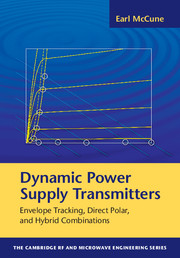Book contents
- Frontmatter
- Dedicaiton
- Contents
- Preface
- List of abbreviations
- Part I Motivations, definitions, and principles
- 1 Motivations
- 2 Definitions
- 3 Dynamic power supply common principles
- 4 Linear power amplifiers
- 5 Envelope tracking principles
- 6 Polar transmitter principles
- Part II DPST circuit issues
- Part III Testing and manufacturability
- Appendix Switching transistor evaluation metrics across technologies
- Index
- References
5 - Envelope tracking principles
from Part I - Motivations, definitions, and principles
Published online by Cambridge University Press: 05 June 2015
- Frontmatter
- Dedicaiton
- Contents
- Preface
- List of abbreviations
- Part I Motivations, definitions, and principles
- 1 Motivations
- 2 Definitions
- 3 Dynamic power supply common principles
- 4 Linear power amplifiers
- 5 Envelope tracking principles
- 6 Polar transmitter principles
- Part II DPST circuit issues
- Part III Testing and manufacturability
- Appendix Switching transistor evaluation metrics across technologies
- Index
- References
Summary
Adding a dynamic power supply (DPS) into a conventional linear transmitter (see Figure 5-1) costs money, requiring a very good reason to go through the time, effort, and expense to do this. That motivation is provided by the wireless communication standards committees, who adopt signal modulations with increasing values of peak-to-average power ratios (PAPR) (see Section 2.6.1). If the signal PAPR is 3 dB or less, then there may not be much advantage to adding the DPS. When the signal PAPR exceeds 5 dB, the advantage of incorporating a DPS into a transmitter in order to improve its energy efficiency builds rapidly.
Envelope tracking (ET) is a DPS technique that aims to improve the energy efficiency of a linear power amplifier (PA) by matching the voltage across the RF power transistor to the lowest practical value needed to accurately provide the present instantaneous output power. The PA power supply therefore tracks alongside the envelope of the output signal with moderate correlation – hence the name: envelope tracking – while leaving the power transistor linear operation nominally unchanged [2-4]. Fundamental to this core principle is that whatever the applied voltage is at the PA, it is not critical to the accuracy of the output signal modulation. Thus, envelope tracking is one of the many techniques used in the century-long quest to build linear power amplifiers and simultaneously to have them be energy efficient.
History of the technique
Recognizing that the efficiency of an amplifier operating below its maximum output signal power is improved by reducing the applied supply and bias voltages includes a key publication from 1989 [5-1]. This does not attempt to follow the signal envelope, but only the signal power, which is a technique now called average power tracking (APT). A power amplifier incorporating a step-varied power supply controlled by the input signal envelope was first published in 1995 [5-2].
- Type
- Chapter
- Information
- Dynamic Power Supply TransmittersEnvelope Tracking, Direct Polar, and Hybrid Combinations, pp. 79 - 114Publisher: Cambridge University PressPrint publication year: 2015

